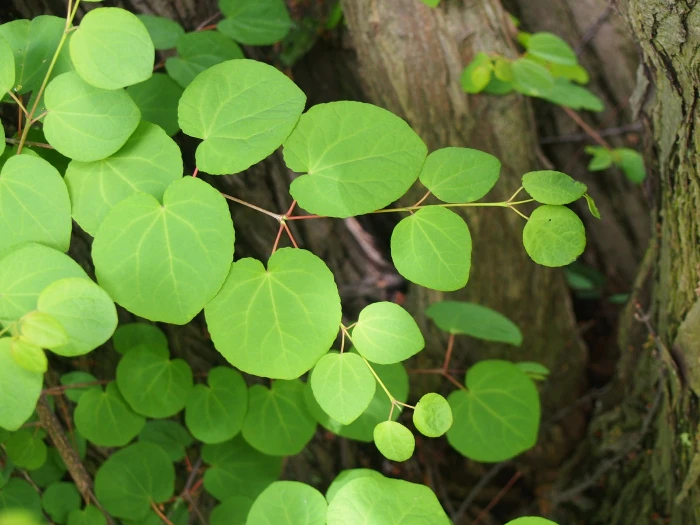Katsura Tree
(Cercidiphyllum japonicum)
Katsura Tree (Cercidiphyllum japonicum)
/
/

Agnieszka Kwiecień, Nova
CC BY-SA 4.0
Image By:
Agnieszka Kwiecień, Nova
Recorded By:
Copyright:
CC BY-SA 4.0
Copyright Notice:
Photo by: Agnieszka Kwiecień, Nova | License Type: CC BY-SA 4.0 | License URL: https://creativecommons.org/licenses/by-sa/4.0 | Uploader: Nova | Publisher: Wikimedia Commons | Title: Cercidiphyllum_japonicum_Grujecznik_japoński_2019-05-05_02.jpg | Notes: {{Information |Description ={{en|1=Location taken: United States Botanic Garden, Washington D.C.. Names: Ilex verticillata f. chrysocarpa B.L.Rob., Black-Alder, Virginia Winterberry, Winterberry, Yellow Fruit Winterberr C






















































Estimated Native Range
Climate Requirements for Maple Grove, Minnesota
| This Plant | Your Site | Plant Suitability for Your Location | ||
|---|---|---|---|---|
| • Precipitation | 18" - 127" | 30" | Your precipitation may be insufficient for this plant. Irrigate N" / year. | Irrigate N" / year |
| • High Temp. | 62°F - 94°F | 84°F | Your summer temperatures are normal for this plant. | Excellent |
| • Low Temp. | -1°F - 45°F | 2°F | Your winter temperatures are normal for this plant | Excellent |
This plant should grow well at your location with about N inches per year (Y minutes per month) of irrigation.
Summary
Cercidiphyllum japonicum, commonly known as the Katsura tree or sometimes caramel tree due to the light caramel smell its leaves emit during fall, is a deciduous tree native to moist woodland areas, forest margins, and along streams in China and Japan. It can grow to a height of 10–45 meters with a trunk diameter of up to 2 meters, though it is often smaller in cultivation. The Katsura tree has a pyramidal shape when young, becoming more rounded with age. Its heart-shaped leaves are highly valued for their beautiful display of colors in autumn, transitioning through a range of yellows, oranges, and pinks. The flowers are inconspicuous, with separate male and female trees (dioecious).
The Katsura tree is appreciated for its stunning fall foliage and the sweet scent reminiscent of caramel or cotton candy that the leaves release when they turn. It is used for ornamental purposes in residential landscapes, parks, and larger gardens. This tree prefers moist, well-drained soils rich in organic matter and can tolerate full sun to part shade. While it is adaptable to different soil conditions, it does not tolerate drought well. There are no major pest or disease problems, but leaf scorch can occur in dry or windy conditions. It is not known for aggressive roots or invasiveness.CC BY-SA 4.0
The Katsura tree is appreciated for its stunning fall foliage and the sweet scent reminiscent of caramel or cotton candy that the leaves release when they turn. It is used for ornamental purposes in residential landscapes, parks, and larger gardens. This tree prefers moist, well-drained soils rich in organic matter and can tolerate full sun to part shade. While it is adaptable to different soil conditions, it does not tolerate drought well. There are no major pest or disease problems, but leaf scorch can occur in dry or windy conditions. It is not known for aggressive roots or invasiveness.CC BY-SA 4.0
Plant Description
- Plant Type: Tree
- Height: 40-60 feet
- Width: 25-60 feet
- Growth Rate: Rapid
- Flower Color: N/A
- Flowering Season: Spring
- Leaf Retention: Deciduous
Growth Requirements
- Sun: Full Sun, Part Shade
- Water: Medium
- Drainage: Fast, Medium, Slow
Common Uses
Bird Garden, Deer Resistant, Fragrant, Low Maintenance, Salt Tolerant, Street Planting
Natural Habitat
Moist woodland areas, forest margins, and along streams in China and Japan
Other Names
Common Names: Japanese Judas Tree , Caramel Tree , Katsura-Tree
Scientific Names: Cercidiphyllum japonicum , Cercidiphyllum japonicum f. pendulum , Cercidiphyllum japonicum var. sinense , Cercidiphyllum japonicum f. piramidale , Cercidiphyllum japonicum var. pendulum , Cercidiphyllum magnificum f. pendulum , Cercidiphyllum ovale
GBIF Accepted Name: Cercidiphyllum japonicum Siebold & Zucc.